Autofocusing of Maneuvering Targets in Terahertz Inverse Synthetic Aperture Radar Imaging Based on Damped Newton Method
Abstract
:1. Introduction
- (1)
- The proposed method did not need to model the trajectory of the target and had strong adaptability. The phase error of the target was estimated by minimizing the entropy of the ISAR image in each iteration.
- (2)
- Since the phase errors between pulses are independent of each other, the simplified Hessian matrix was used to improve the calculation efficiency. The variable step-size factor, introduced to avoid the entropy function falling into the local optimal solution, was decided by the golden section method [29], which ensured the stable decline of image entropy and further improved the robustness of MEA under a low SNR.
- (3)
- A large number of experimental results based on the measured data of 0.32 THz radar verified the effectiveness and robustness of the proposed DN-MEA method.
2. Signal Model for ISAR Imaging
3. The Proposed Methodology
4. Experimental Results and Analysis
4.1. Experiment Set-Up
4.2. Tests and Results with Point Target Imaging
4.3. Tests and Results with UAV Imaging
5. Discussion
6. Conclusions
Author Contributions
Funding
Institutional Review Board Statement
Informed Consent Statement
Data Availability Statement
Acknowledgments
Conflicts of Interest
Appendix A
References
- Özdemir, C. Inverse Synthetic Aperture Radar Imaging with MATLAB® Algorithms; John Wiley & Sons: Hoboken, NJ, USA, 2021. [Google Scholar] [CrossRef]
- Wang, Y.; Kang, J.; Jiang, Y. ISAR Imaging of Maneuvering Target Based on the Local Polynomial Wigner Distribution and Integrated High-Order Ambiguity Function for Cubic Phase Signal Model. IEEE J. Sel. Top. Appl. Earth Obs. Remote Sens. 2014, 7, 2971–2991. [Google Scholar] [CrossRef]
- Wang, F.; Xu, F.; Jin, Y. Three-Dimensional Reconstruction From a Multiview Sequence of Sparse ISAR Imaging of a Space Target. IEEE Trans. Geosci. Remote Sens. 2017, 56, 611–620. [Google Scholar] [CrossRef]
- Wei, Y.; Yeo, T. Weighted least-squares estimation of phase errors for SAR/ISAR autofocus. IEEE Trans. Geosci. Remote Sens. 1999, 5, 2487–2494. [Google Scholar] [CrossRef]
- Cooper, K.B.; Dengler, R.J.; Chattopadhyay, G.; Schlecht, E.; Gill, J.; Skalare, A.; Mehdi, I.; Siegel, P.H. A High-Resolution Imaging Radar at 580 GHz. IEEE Microw. Wirel. Compon. Lett. 2008, 18, 64–66. [Google Scholar] [CrossRef]
- Mostajeran, A.; Naghavi, S.; Emadi, M.; Samala, S.; Ginsburg, B.P.; Aseeri, M.; Afshari, E. A High-Resolution 220-GHz Ultra-Wideband Fully Integrated ISAR Imaging System. IEEE Trans. Microw. Theory Tech. 2018, 67, 429–442. [Google Scholar] [CrossRef]
- Zhang, Y.; Yang, Q.; Deng, B.; Qin, Y.; Wang, H. Experimental Research on Interferometric Inverse Synthetic Aperture Radar Imaging with Multi-Channel Terahertz Radar System. Sensors 2019, 19, 2330. [Google Scholar] [CrossRef]
- Cheng, B.; Ge, J.; Cheng, W.; Chen, Y.; Cai, Y.; Qi, C.; Xiang, H.; Zeng, G.; Jiang, J.; Deng, X. Real-time imaging with a 140 ghz inverse synthetic aperture radar. IEEE Trans. Terahertz Sci. Technol. 2013, 3, 594–605. [Google Scholar] [CrossRef]
- Danylov, A.; Goyette, T.; Waldman, J.; Coulombe, M.; Gatesman, A.; Giles, R.; Qian, X.; Chandrayan, N.; Vangala, S.; Termkoa, K.; et al. Terahertz inverse synthetic aperture radar (ISAR) imaging with a quantum cascade laser transmitter. Opt. Express 2010, 18, 16264–16272. [Google Scholar] [CrossRef]
- Liu, T.; Pi, Y.; Yang, X. Wide-Angle CSAR Imaging Based on the Adaptive Subaperture Partition Method in the Terahertz Band. IEEE Trans. Terahertz Sci. Technol. 2017, 8, 165–173. [Google Scholar] [CrossRef]
- Liang, M.; Zhang, C.; Zhao, R.; Zhao, Y. Experimental 0.22 THz Stepped Frequency Radar System for ISAR Imaging. J. Infrared Millim. Terahertz Waves 2014, 35, 780–789. [Google Scholar] [CrossRef]
- Shi, S.; Li, C.; Hu, J.; Zhang, X.; Fang, G. Motion Compensation for Terahertz Synthetic Aperture Radar Based on Subaperture Decomposition and Minimum Entropy Theorem. IEEE Sens. J. 2020, 20, 14940–14949. [Google Scholar] [CrossRef]
- Zhang, B.; Pi, Y.; Li, J. Terahertz Imaging Radar with Inverse Aperture Synthesis Techniques: System Structure, Signal Processing, and Experiment Results. IEEE Sens. J. 2015, 15, 290–299. [Google Scholar] [CrossRef]
- Jiang, Y.; Liu, K.; Wang, H.; Deng, B.; Zhuang, Z. Orbital-Angular-Momentum-Based ISAR Imaging at Terahertz Frequencies. IEEE Sens. J. 2018, 18, 9230–9235. [Google Scholar] [CrossRef]
- Li, H.; Li, C.; Wu, S.; Zheng, S.; Fang, G. Adaptive 3D Imaging for Moving Targets Based on a SIMO InISAR Imaging System in 0.2 THz Band. Remote Sens. 2021, 13, 782. [Google Scholar] [CrossRef]
- Yang, Q.; Zeng, Y.; Zhang, Y.; Wang, H.; Deng, B.; Qin, B.D.Y. Envelope Correction of Micro-Motion Targets Based on Multi-Layer Perceptron During THz-ISAR Sensing. IEEE Access 2019, 7, 183596–183603. [Google Scholar] [CrossRef]
- Yang, Q.; Deng, B.; Wang, H.; Qin, Y.; Zhang, Y. Envelope Correction of Micro-Motion Targets in the Terahertz ISAR Imaging. Sensors 2018, 18, 228. [Google Scholar] [CrossRef]
- Zhang, Y.; Yang, Q.; Deng, B.; Qin, Y.; Wang, H. Estimation of Translational Motion Parameters in Terahertz Interferometric Inverse Synthetic Aperture Radar (InISAR) Imaging Based on a Strong Scattering Centers Fusion Technique. Remote Sens. 2019, 11, 1221. [Google Scholar] [CrossRef]
- Zhang, S.; Liu, Y.; Li, X. Fast Entropy Minimization Based Autofocusing Technique for ISAR Imaging. IEEE Trans. Signal Process. 2015, 63, 3425–3434. [Google Scholar] [CrossRef]
- Wu, H.; Grenier, D.; Delisle, G.; Fang, D.G. Translational motion compensation in ISAR image processing. IEEE Trans. Image Process. 1995, 4, 1561–1571. [Google Scholar] [CrossRef]
- Zhu, Z.; Qiu, X.; She, Z. ISAR motion compensation using modified Doppler centroid tracking method. In Proceedings of the IEEE 1996 National Aerospace and Electronics Conference NAECON 1996, Dayton, OH, USA, 20–22 May 1966. [Google Scholar]
- Kim, K.; Yang, E.; Chan, H.; Park, S. Improvement of ISAR Autofocusing Performance Based on PGA. J. Korea Inst. Mil. Sci. Technol. 2014, 5, 680–687. [Google Scholar] [CrossRef]
- Wang, B.; Cha, H.; Zhou, Z.; Tang, H.; Sun, L.; Du, B.; Zuo, L. An Iterative Phase Autofocus Approach for ISAR Imaging of Maneuvering Targets. Electronics 2021, 10, 2100. [Google Scholar] [CrossRef]
- Cai, J.; Martorella, M.; Chang, S.; Liu, Q.; Ding, Z.; Long, T. Efficient Nonparametric ISAR Autofocus Algorithm Based on Contrast Maximization and Newton’s Method. IEEE Sens. J. 2020, 21, 4474–4487. [Google Scholar] [CrossRef]
- Kang, H.; Li, J.; Zhang, Z.; Ma, H.; Li, H. Robust calibration method for distributed ISAR time-varying frequency errors based on the contrast maximisation principle. IET Radar Sonar Navig. 2020, 14, 1068–1078. [Google Scholar] [CrossRef]
- Liu, Q.; Wang, Y. A Fast Eigenvector-Based Autofocus Method for Sparse Aperture ISAR Sensors Imaging of Moving Target. IEEE Sens. J. 2018, 19, 1307–1319. [Google Scholar] [CrossRef]
- Xi, L.; Li, G.; Ni, J. Autofocusing of ISAR images based on entropy minimization. IEEE Trans. Aerosp. Electron. Syst. 1999, 35, 1240–1252. [Google Scholar] [CrossRef]
- Wang, J.; Liu, X.; Zhou, Z. Minimum-entropy phase adjustment for ISAR. IEE Proc.-Radar Sonar Navig. 2004, 4, 203–209. [Google Scholar] [CrossRef]
- McDougall, T.; Wotherspoon, S. A simple modification of Newton’s method to achieve convergence of order. Appl. Math. Lett. 2014, 29, 20–25. [Google Scholar] [CrossRef]
- Nocedal, J.; Wright, S.J. Numerical Optimization, 2nd ed.; World Scientific: Singapore, 1999. [Google Scholar]
- Peng, S.; Xu, J.; Peng, Y.; Xiang, J. Parametric inverse synthetic aperture radar maneuvering target motion compensation based on particle swarm optimizer. IET Radar Sonar Navig. 2011, 5, 305–314. [Google Scholar] [CrossRef]
- Zhang, L.; Sheng, J.; Duan, J.; Xing, M.; Qiao, Z.; Bao, Z. Translational motion compensation for ISAR imaging under low SNR by minimum entropy. EURASIP J. Adv. Signal Process. 2013, 2013, 33. [Google Scholar] [CrossRef] [Green Version]
- Kang, M.; Lee, S.; Lee, S. ISAR imaging of high-speed maneuvering target using gapped stepped-frequency waveform and compressive sensing. IEEE Trans. Image Process. 2017, 26, 5043–5056. [Google Scholar] [CrossRef]
- Kong, L.; Zhang, W.; Zhang, S.; Zhou, B. Radon Transform and the Modified Envelope Correlation Method for ISAR Imaging of Multi-Target. In Proceedings of the 2010 IEEE Radar Conference, Arlington, VA, USA, 10–14 May 2010; pp. 637–641. [Google Scholar] [CrossRef]
- Walker, J. Range-Doppler imaging of rotating objects. IEEE Trans. Aerosp. Electron. Syst. 1980, 16, 23–52. [Google Scholar] [CrossRef]
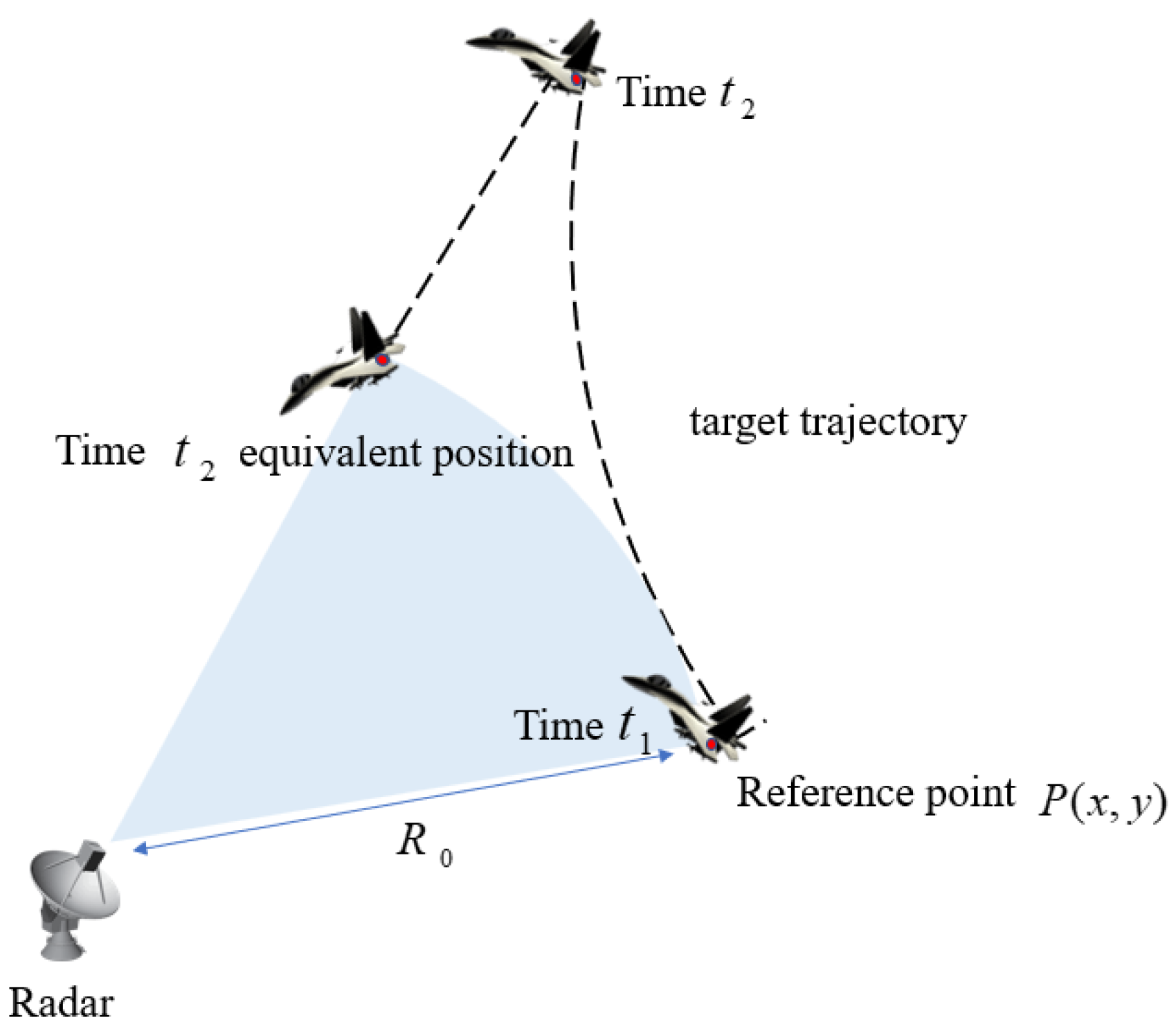
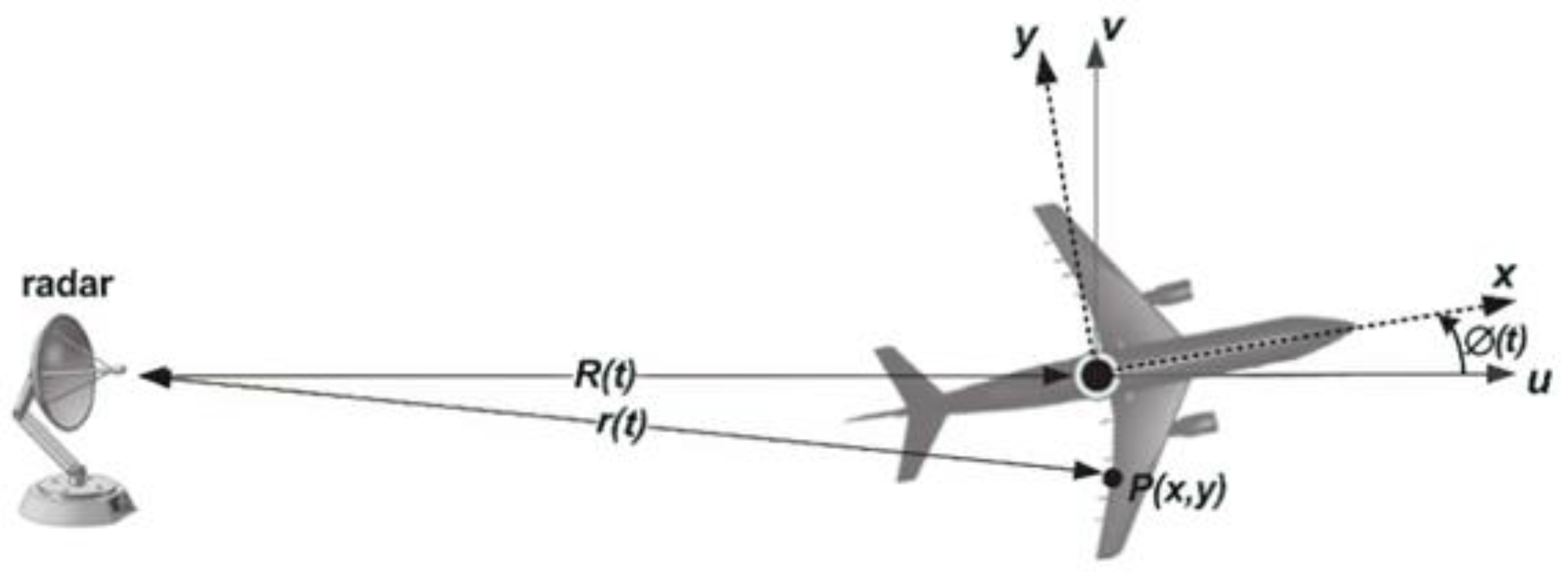


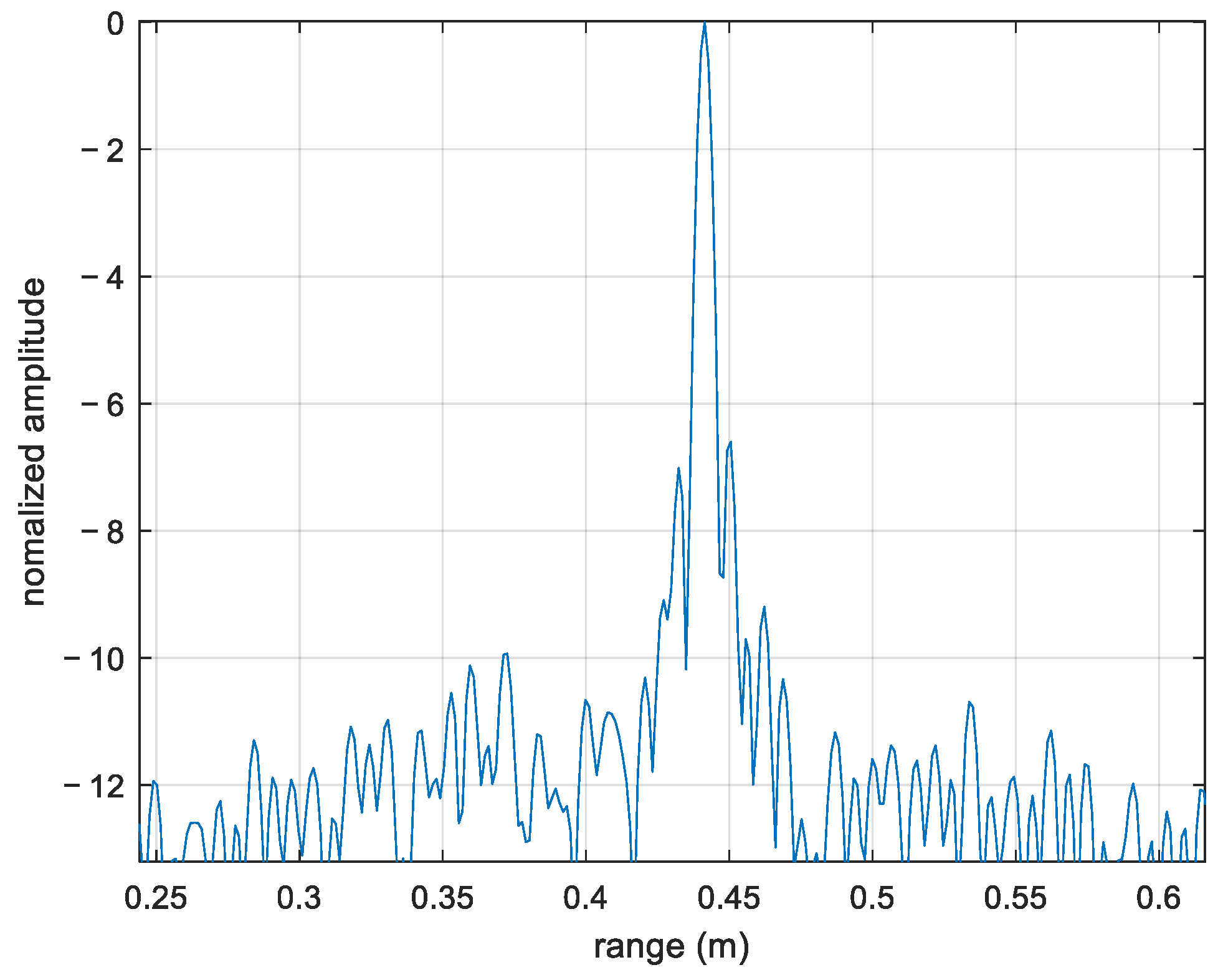

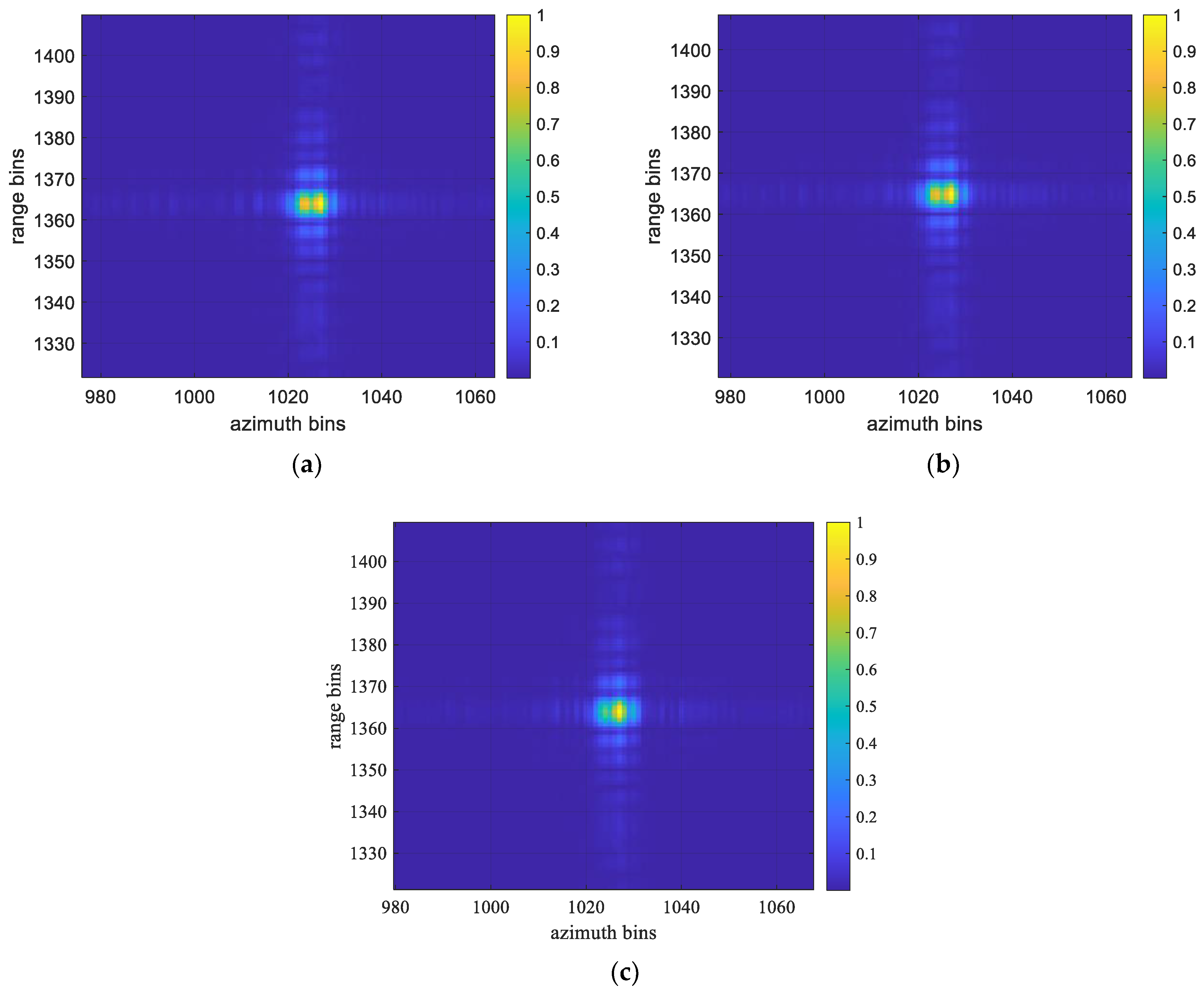




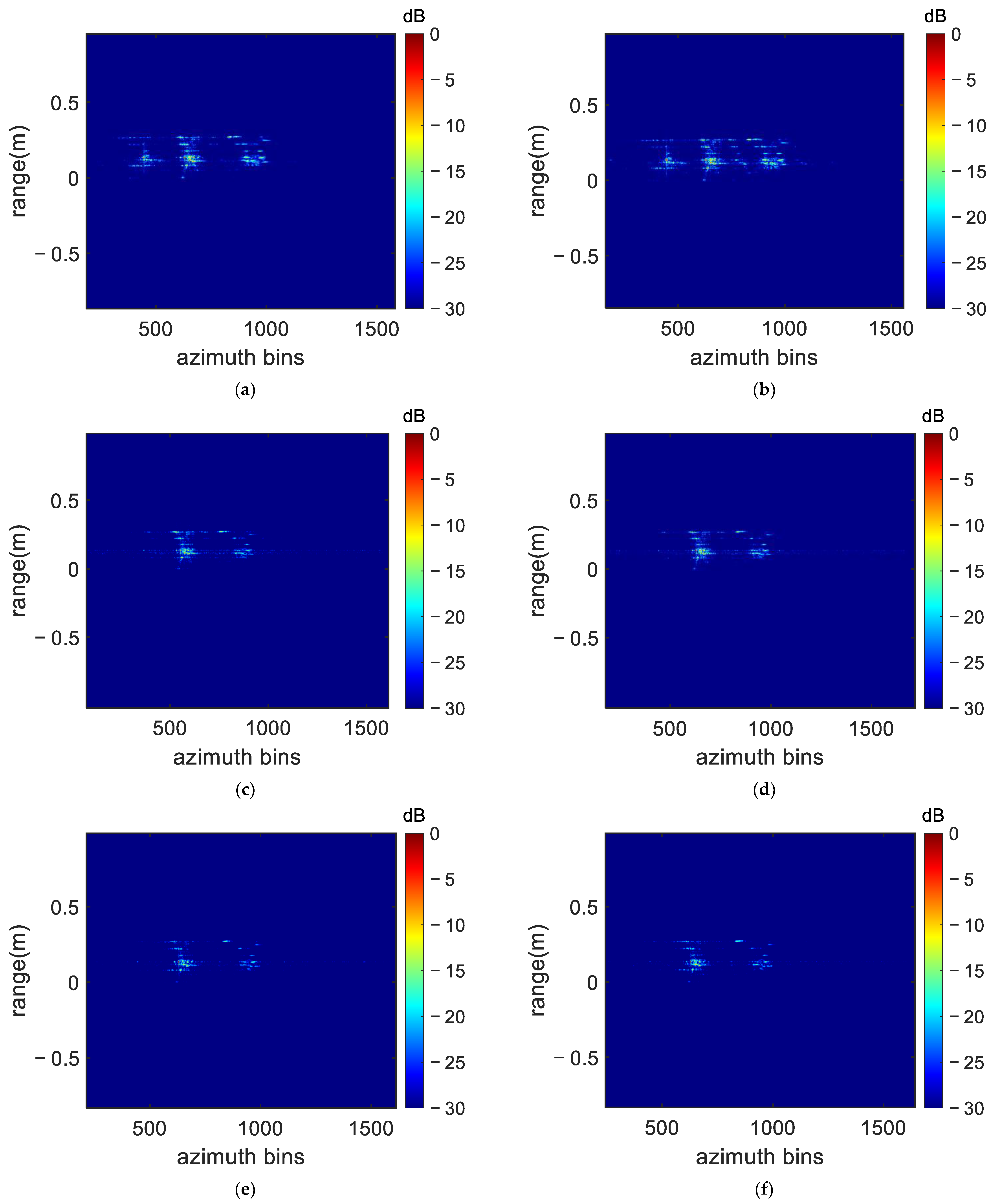
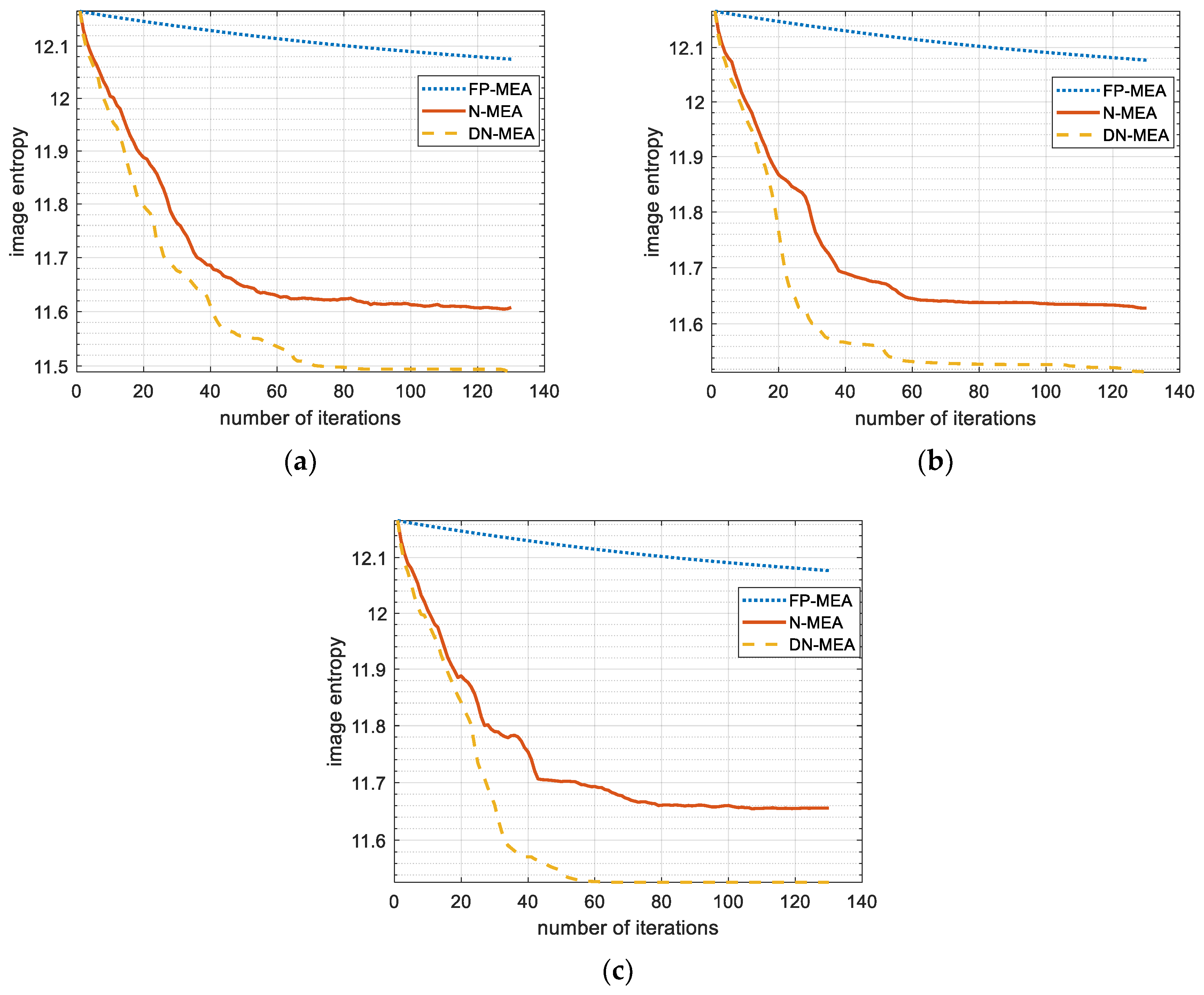
| Method | Robustness | Precision | Computational Efficiency | Adaptability |
|---|---|---|---|---|
| Parameterization based on heuristic search [31] | strong | low | high | weak |
| Joint envelope alignment and phase average compensation [26,32] | weak | high | average | average |
| Regularization and sparse class methods [33] | average | high | high | average |
| Image-quality-measurement-based methods [24,25] | strong | average | low | strong |
| Parameter | Symbol | Value |
|---|---|---|
| Carrier frequency | fc | 0.32 THz |
| Bandwidth | B | 28.8 GHz |
| Pulse width | Tp | 0.3 ms |
| IF sampling frequency | fs | 1.56 MHz |
| Pulse repetition frequency | PRF | 1000 |
| Pulse number | N | 1000 |
| Pulse sampling points | M | 2048 |
| Range resolution | ρ | 5.2 mm |
| Metrics | FP-MEA | N-MEA | DN-MEA |
|---|---|---|---|
| ISLR | −3.4549 | −4.2243 | −5.0657 |
| PSLR | −4.7789 | −5.9788 | −8.7456 |
| Algorithms | Indicators | Original Data | −5 dB | −10 dB |
|---|---|---|---|---|
| FP-MEA | Image entropy | 11.7602 | 11.7887 | 11.8033 |
| Image contrast | 17.2855 | 16.9824 | 15.5231 | |
| N-MEA | Image entropy | 11.6461 | 11.6823 | 11.7056 |
| Image contrast | 22.8327 | 21.8398 | 19.6554 | |
| DN-MEA | Image entropy | 11.5264 | 11.5319 | 11.5384 |
| Image contrast | 29.5762 | 28.0903 | 26.0834 |
Publisher’s Note: MDPI stays neutral with regard to jurisdictional claims in published maps and institutional affiliations. |
© 2022 by the authors. Licensee MDPI, Basel, Switzerland. This article is an open access article distributed under the terms and conditions of the Creative Commons Attribution (CC BY) license (https://creativecommons.org/licenses/by/4.0/).
Share and Cite
Wang, H.; Yang, Q.; Wang, H.; Deng, B. Autofocusing of Maneuvering Targets in Terahertz Inverse Synthetic Aperture Radar Imaging Based on Damped Newton Method. Sensors 2022, 22, 6883. https://doi.org/10.3390/s22186883
Wang H, Yang Q, Wang H, Deng B. Autofocusing of Maneuvering Targets in Terahertz Inverse Synthetic Aperture Radar Imaging Based on Damped Newton Method. Sensors. 2022; 22(18):6883. https://doi.org/10.3390/s22186883
Chicago/Turabian StyleWang, Hetong, Qi Yang, Hongqiang Wang, and Bin Deng. 2022. "Autofocusing of Maneuvering Targets in Terahertz Inverse Synthetic Aperture Radar Imaging Based on Damped Newton Method" Sensors 22, no. 18: 6883. https://doi.org/10.3390/s22186883




